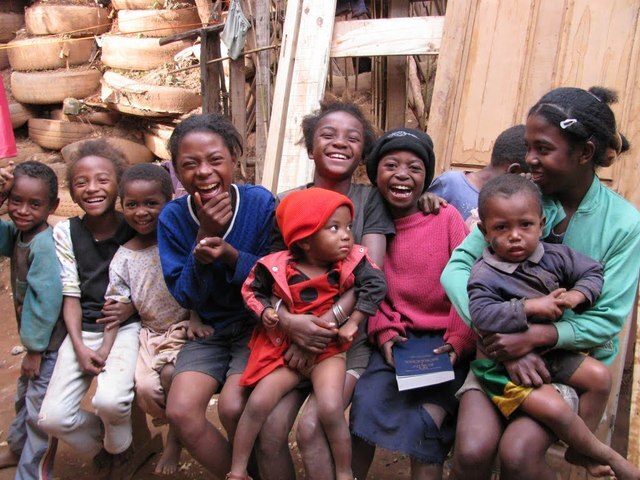Children with dusty feet playing in the trash. Street vendors begging tourists to buy their vanilla. Women scrubbing laundry in the muddy river. Soldiers with AK-47s patrolling the streets.
This is Madagascar.
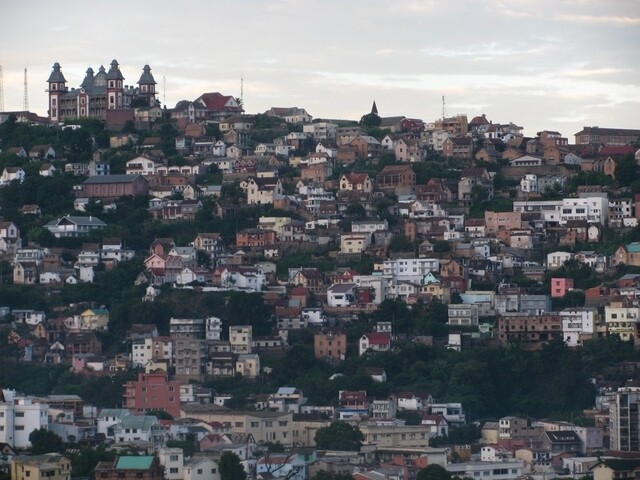
City shot of Antananarivo.
But on this enormous island, you’ll also see children reading the Book of Mormon, priesthood holders walking miles to attend sacrament meeting, and women bringing their Relief Society sisters the occasional bag of rice. Humble, loving people in Madagascar have embraced the gospel of Jesus Christ—and they’re not letting go.
Establishing the Church
For many years, Madagascar was a part of the South Africa Johannesburg Mission. Once the Church received legal status in 1993, membership in Madagascar grew rapidly. After only five years, the Madagascar Antananarivo Mission was created. The mission now includes all of Madagascar, which is nearly the size of Texas, and two other islands in the Indian Ocean: La Réunion (a province of France) and Mauritius. Madagascar itself is home to over 21 million natives and only about 60 missionaries. But despite the overwhelming odds, hard-working missionaries and members continue to spread the gospel all throughout Madagascar.
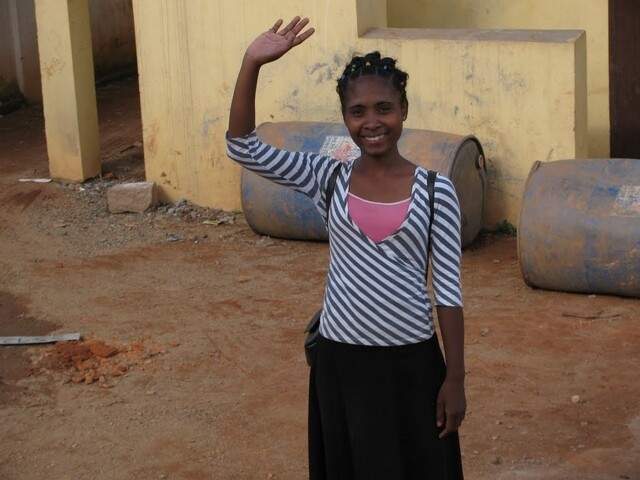
Mirina, a member who served every day with the missionaries.
Even though the people of Madagascar, known as Malagasies, waited so long to receive the gospel, once it arrived, they were quick to gain strong testimonies and live by its principles. The Church now has two stakes in the capital city of Antananarivo and two districts in outlying areas, not to mention branches and groups spread all throughout the country in remote places only accessible by long drives in cramped buses.
Sean Donnelly, who was just released as mission president, helped the Church leap forward in the past three years to touch the most remote places of Madagascar. These incredibly distant areas carry the Church from the northern coast of Mahajanga to the southern beaches of Fort Dauphin, from the southwest, newly opened area of Toliara to the northeastern seaboard of Toamasina. “When we got here three years ago, we had about 5,500 members in the whole mission,” says Donnelly. “Now we have nearly 10,000. In 2009, the Church had 29 units [wards or branches]. We have 49 units now.”
Finding the Faithful
Those 49 units of the Church meet in everything from renovated restaurants to rain-soaked rice fields. A few years ago, the Church built a five-story meeting house in Antananarivo, where three wards meet. Its orange walls tower over the city, making not only the building stand out but the Church as well. Malagasies all around know about “the orange church” and its vahaza (foreign) missionaries. But very few branches meet in houses with electricity and water; most meet in the miniscule homes of faithful members. Some of the growing groups and branches even meet outside in the sweltering sun. The mission tries to keep up with the demand of the booming areas, but often, members teach the gospel to their friends until the missionaries arrive.
In the Antsirabe district, the branch of Sarodroa is a two-hour trip from town: one hour riding in a rickety bus with wall-to-wall seating and one hour hiking up the mountainous terrain to the village. The members in the isolated valley began spreading the good news of the restored gospel faster than the missionaries could keep up with the lessons. When Elder and Sister Bennett, the senior missionaries from Tahiti, first arrived in Sarodroa, the villagers were out working in the fields.
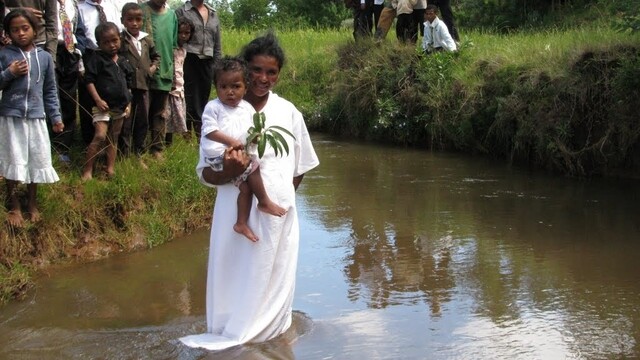
Sarodroa baptism in the river.
“When we arrived, a sister whistled to signal the presence of the missionaries and that the lessons would start. Little by little, we saw them come down from the hills and gather together,” says Sister Bennett. “The first few lessons on the plan f redemption were like a balm of comfort that had arrived in their lives.”
The first few sacrament meetings were held outside on makeshift benches under cherry blossom trees. The small group soon became a branch after more than 100 people started coming to church on Sundays. Now the branch missionaries play a key role in the conversion of most of the new members. When investigators are baptized, the branch members follow a dirt trail from where they hold sacrament meeting to the river that runs through the valley. Its shallow, copper-brown waters have a special meaning for each member in Sarodroa: not only does the river give them their physical livelihood, but its waters have also helped them gain a remission of their sins.
Creating the Family
Often, the road to baptism is not easy for these humble, dedicated people. Couples living together must be married to be worthy of baptism, but in the Malagasy culture, a marriage is an extremely expensive process. A large feast is expected for friends and family, and copies of the couple’s birth certificates must be provided for the civil marriage. In third-world Madagascar, the government is not established well enough to help in the process of obtaining the certificates. Each certificate must be collected in person at the birthplaces of the bride and groom. A ticket for a bus ride back to their hometowns can cost more than the money for three weeks of food—a price much too high for those living from day to day. Consequently, couples often start their families without being married civilly, or receiving their vita soratra, which literally means “finished writing” of marriage.
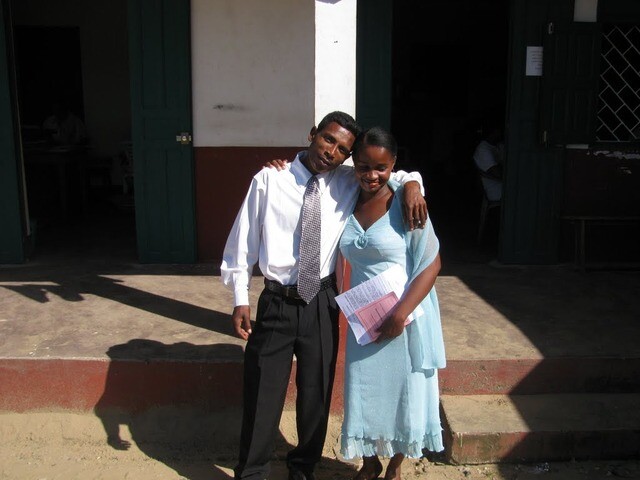
A newly married couple ready for baptism.
One couple, Claire and Hery, lived in Tanjombato, a suburb of Antananarivo. Claire had long wanted to come to church, but Hery was skeptical. He sported long dreadlocks, usually held back by a large red, black, and yellow beanie. When the sister missionaries arrived at their two-room house, Bob Marley and Avril Lavigne posters covered the walls. Despite Hery’s rough exterior, he eventually came to church and tried to quit smoking and drinking. When the sister missionaries returned one evening, they were shocked to find that Hery had cut off all his dreadlocks. That night during the lesson, he ripped down the posters and said he would begin reading The Book of Mormon in earnest. One of the sister missionaries who taught Hery and Claire says, “To me, they are great examples of faith, endurance, repentance, and humility. It was amazing to watch their lives change through the gospel of Jesus Christ.”
They wanted to be baptized, but Hery and Claire didn’t have their vita soratra, and Hery’s birth certificate was 200 miles away in Fianarantsoa. The missionaries and one member filled with charity in Fianarantsoa worked diligently to obtain Hery’s birth certificate, which they could collect in person on his behalf. Hery, Claire, and the missionaries fasted and prayed that the certificates would be found. Eight months later, the certificates arrived, the couple married, and the newlyweds entered the waters of baptism together.
Living Amidst Turmoil
The members’ difficulty with marriages and birth certificates springs from deeper political turmoil that affects not only their daily lives of little food and little work but also the missionaries’ lives of preaching the gospel. In 2009, the president of Madagascar was overthrown, and the country fell under the control of one man heavily backed by the military. The effects of the coup d’état left the economy, the members, and the missionaries suffering. To this day, when opposing forces battle and riots flood the streets, Antananarivo transforms from a city of commerce to a city of warfare.
In the heart of Antananarivo, the mission home sits in the middle of a steep hill across the street from a military outpost. The home houses a chapel, the mission office, and the mission president’s personal home. In February 2010, the building was caught in the crossfires of a 12-hour battle between rebels and soldiers. “Our geographic location was right in the middle, between the military and the police,” says Donnelly. “The soldiers stood behind our trash [dumpster] and were shooting up the hill, and we had soldiers come into the chapel grounds behind the gate and use our wall as a protection.” Some shots hit the transformer of the mission home, wiping out the building’s electricity. President Donnelly was away visiting another part of the island when he discovered that the mission assistants and a senior couple were trapped in the basement while bullets whizzed around the building.
“We had to do some commando tactics to get them out,” says Donnelly. He had the assistants on one phone and the mission chauffeur on another, trying to coordinate the rescue. Miraculously, halfway through the battle, the fighting stopped for about an hour. Just then, the driver went to the barricade and asked if he could drive through. The soldier at the barricade told the driver that he could enter—but only at his own risk. Donnelly told the assistants to collect all of the passports and the money and to divide them equally between them.
“First I told the missionaries to stand by. Then I told Roger, the driver, to ‘Go, go, go!’ And I told the assistants to ‘Go, go, go!’ It was like Starsky and Hutch in the no-man zone.” The assistants and the senior couple rushed out of the building, past the gate, and into the van—completely unscathed. “I have personally driven through riots, and we have been protected,” says Donnelly, proving that the Lord watches over the members and missionaries who live in this dangerous country where mobs combine and armies assemble.
Walking Out of Poverty
Because of the toppled government in Madagascar, all aid from the Western world has ceased, and the people have sunk even further into poverty. The gross domestic product (GDP) per capita is one of the lowest in the world: $900 per person in 2011, compared to the U.S.’s $49,000. But as the economy has gone down, the success of the Church has gone up. “The Lord brings the gospel to these people to bless them and help them. The Church has the divine plan of helping the poor.”
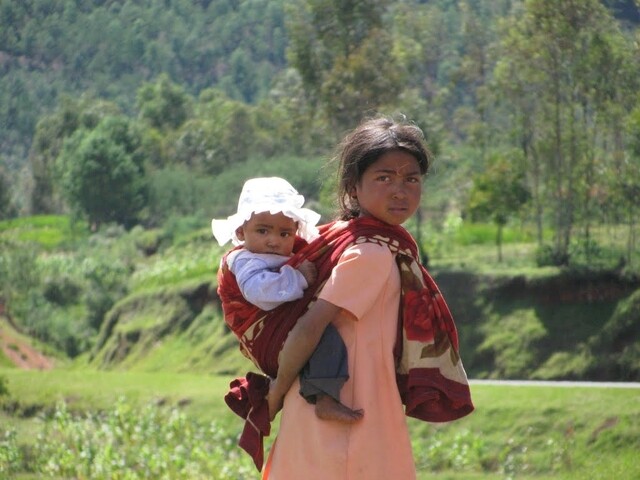
That plan has developed into the first Church-sponsored food initiative in Madagascar. The Church provides the members with seeds and square-foot gardening plots to help families become self-sufficient. Since unemployment also reigns high among the population, the first missionaries from the Perpetual Education Fund also arrived in July of this year. Now, members will receive help to pay for schooling in a specific trade—bus driver, nurse, teacher, plumber—anything to provide a steady income.
President Donnelly has seen firsthand the difference the Church can make in the lives of its Malagasy members. When he would take his daily morning run, he often saw a young man named Daniel digging through the trash heap for bottles. He spoke with Daniel, who told Donnelly that he and his sister Lanto were living on the street with no prospects of employment whatsoever.
“We started helping him by giving him recyclable bottles from the mission,” says Donnelly. “I invited him to hear the discussions, and after he met the missionaries the first time, he and his sister went to church every Sunday. And I baptized both him and his sister.” Now Daniel and Lanto have jobs and live in a house of their own. “He’s paying his tithing, and he’s having success. He received the priesthood, and now he’s walking out of poverty.” The mission gave Lanto a weighing scale, and she makes a living by sitting on the crowded steps of Antananarivo charging people to use her scale. “She’s become self-reliant,” says Donnelly. “Now she has a Relief Society, and she has sisters. That’s the real story.”
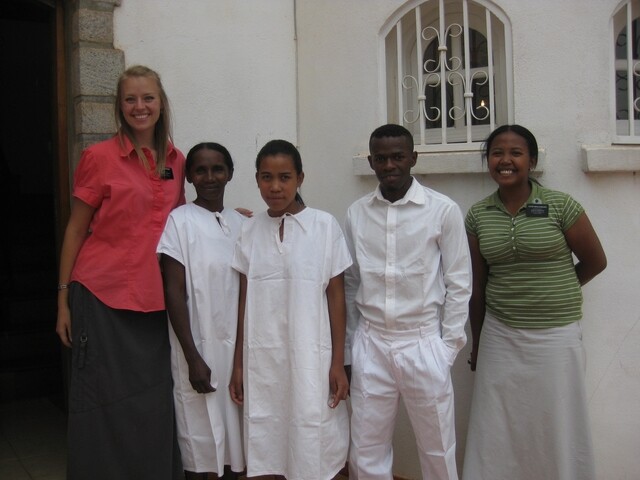
Baptism of two new members; Sister Jenny Spencer at left.
Welcoming a Special Witness
In October 2011, Elder Russell M. Nelson visited the red island for four miraculous days. He was accompanied by Elder Ronald A. Rasband and Elder Richard C. Edgley. It was a momentous occasion since this was only the second time that the members had met an Apostle.
Malagasy members spent countless hours preparing for Elder Nelson’s visit. Many worked extra jobs to save enough money just to pay the bus fare to the capital city. Over 2,500 members (the largest number of Malagasy members ever to assemble) congregated in Antananarivo to listen to Elder Nelson’s counsel. Dressed in red, white, and green—the colors of the Madagascar flag—a choir of over 300 young adult voices welcomed the General Authorities.
“When we walked in the room, they began to sing. [Elder Nelson] stood right in front of the choir, and it was like heaven,” says Donnelly. “They knew he was a special witness of Christ.”
Elder Nelson gave a wonderful message of faith and love. He asked all of the children in the congregation to stand on their chairs. He then told their parents to teach them to love their Father in Heaven and to pray to Him often. After addressing many gospel topics, he shook the hand of every person in attendance, and they warmly returned his inspiring grasp.
“I’ve been to about 40 different countries in my life,” says Donnelly. “And these are the warmest people I’ve ever met. They’re generous and respectful despite their poverty. And they are people of great faith.”
This article was originally published in the September/October 2012 issue of LDS Living. Subscribe or buy a single copy.
